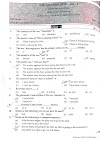1. Subject: English Ful Marks: 20
Comprehension of reading passages on a variety of topics and styles with special references to (i) General English and (ii) Technical English.
Grammar – Familiarity with the following aspects:
Parts of Speech, Basic Grammatical Patterns
/ Structures, Tense and Aspect,
Conditional sentences, Verbals:
infinitives, Participles and Gerunds, Direct and Indirect Speech, Active
and Passive Voice, Kinds of Sentences, Transformation of sentences, Concord
/Agreement, Vocabulary, Use of Prepositions, Idiomatic expressions, Punctuation, Phonemes and phonetic
symbols, Word Stress.
Non-Metals
Water: Hard water and soft water, Causes and
removal of hardness of water; Nitrogen
and its Compounds: Nitrogen cycle, Preparation of ammonia and nitric acid in the lab, and their properties, Manufacture of ammonia
and nitric acid, Sulphur and its Compound.
Allotropy of sulphur, Preparation of hydrogen sulphide, sulphure dioxide in the lab, and their
properties, Manufacture of sulphuric acid by contact process;
Halogens and Their Compound: Position of halogens in the periodic table, Preparation of chlorine and hydrogen chloride
in the lab, and their
properties.
Metals
Compounds
of Metals: General methods of preparation and properties of oxides, hydroxides, chlorides, nitrates, sulphates and carbonates of metals; Sodium:
Extraction of Sodium (Down's process), Manufacture of caustic soda sodium carbonate; Copper: Extraction of copper from copper pyrite,
Manufacture of Blue vitriol; Zinc: Extraction of zinc from zinc blend,
Galvanization; Iron:
Extraction of cast iron from hematite, Cast iron, steel and wrought
iron, Types of steel, Manufacture of steel
Organic Chemistry
Sources
and Purification of Organic Compounds: Characteristics of organic compounds, Sources of organic compounds, Purification of organic compounds; Classification and nomenclature of organic Compounds: Functional group, homologous
series,
and isomerism (structural only), Classification of organic compounds, Common names, and I.U.P.A.C. naming
system
Saturated and unsaturated Hydrocarbons & Aromatic compounds
Preparation and properties of methane, Preparation and properties of ethylene and acetylene, Alkyl Halides: Preparation and properties of ethyl iodide;
Aromatic Compounds: Structure of benzene, Preparation of benzene in the laboratory, Properties of benzene
Dimensions, Equations of motion, Motion of a projectile. Laws of motion. Addition and subtraction of vectors. Relative velocity. Equilibrium of forces. Moments. Centre of mass. Centre of gravity. Solid friction. Work, power and energy. Conservation of energy. Angular speed. Centripetal force. Moment of inertia. Torque on a body. Angular momentum. Rotational kinetic energy. Laws of gravitation. Gravitational intensity, Gravitational potential. The velocity of escape. Simple harmonic motion. The energy of SHM. Hooke’s Law. Breaking stress. Modules of elasticity. Energy is stored in the stretched wire. Surface tension phenomenon. Surface energy. Capillarity. Fluid pressure. Pascal's law of transmission of fluid pressure. Archimedes' principle. Flotation Stokes' law. Terminal velocity,
Heat
Heat and temperature. Temperature scale. Measurement of heat energy. Specific heat capacity. Latent heat. Saturated and Unsaturated vapour. Relative humidity and dew point. The first law of thermodynamics. Reversible isothermal and adiabatic changes. Gas laws. Kinetic theory of gases. Second Law of thermodynamics. Carnot's engine. Transfer of Heat. Conduction, convection and radiation. Expansion
of solid, liquid
and gas.
Optics
Formation of images by plane and curved mirrors.
Refraction of light through-plane surfaces. Total
internal reflection. Critical angle. Refraction through a prism. Maximum and minimum deviation. Formation of images by lenses. Dispersion. Achromatic combination of lenses visual angle. Angular magnification. Defect of vision. Telescope and microscope. Wave theory of light: introduction to Huygen's principle and its application interference diffraction and polarization of light.
Sound
Damped vibration.
Forced oscillation. Resonance. Progressive waves, Principle of superposition. The velocity of sound in solid, liquid and gas: Laplace’s correction. Characteristics of a Sound wave. Beat phenomenon. Doppler effect. Stationary waves. Waves
in pipes. Waves in String.
Electricity
Electric
Charge. Gold leaf electroscope. Charging by induction Faraday's ice pail experiment. Coulomb's law. Permittivity. Electric
field. Gauss's law and its application. Electric potential. Capacitors.
Ohm's Law. Resistance–a combination of resistances. emf. Kirchhoff's law and its application. Heating effect of current. Thermoelectricity. Chemical effect of current. Potentiometer. Wheatstone bridge. Galvanometer. Conversion of galvanometer into voltmeter and ammeter. Magnetic Field. Earth's magnetism. Magnetic Flux. Force
on a current-carrying conductor. Ampere's law, Biot-Savart's law and their applications. Solenoid. Electromagnetic induction.AC circuits.
Atomic Physics and Electronics:
Discharge
electricity through gases. Cathode rays.
Electronic mass and charge Bohr's theory of atomic structure. Energy level. X-rays.
Photoelectric effect Radioactivity. Nuclear – fission
and fusion.
Semiconductors. Junction
Transistor.
Subject: Mathematics Full Marks: 50
Set and Function
Set and relations, Functions and graphs, Algebraic, Trigonometric, Exponential, Logarithmic and hyperbolic functions and their inverses.
Algebra
Determinants, matrices, Inverse of a matrix, use of complex numbers, Polynomial equations, sequence and series, Permutation and combination, Binomial theorem, exponential, and Logarithmic series.
Trigonometry
Coordinate Geometry
Coordinates in a plane, Straight lines, Pair of lines, Circles, Conic sections: Parabola, ellipse and hyperbola. Standard equations and simple properties, Coordinates in space, Plane and its equation.
Calculus
Limit and continuity of functions, Derivatives and application of derivatives – Tangent and normal, Rate of change, differentials dy and actual change Dy. Maxima and Minima of a function.; Antiderivatives (Integrations): rules of Integration, Standard Integrals, and Definite integral as the limit of a sum. Application to areas under a curve and areas between two curves.
Vectors
Vectors in space, the addition of vectors. Linear combination of vectors, Linearly dependent and independent set of vectors, Scalar and vector product of two vectors, simple applications



![[UPDATED] New Syllabus of IOE Entrance Examination |](https://blogger.googleusercontent.com/img/b/R29vZ2xl/AVvXsEj5C60n4l8guBTBqS4sBFaD1z9AoLPnKFQB_f1-F731bzrW_xcCsoewcBcUtqnpJhlf7lL5sOklAtsxRKdgZ-dCQiAgQb1T2X9ck-D_FYoU01fPdPA0mbsulZgmnkS-6-3Hg_CbxBExwn3z5c3-8srStMoZwr6SrmsgF5fPGjnD29T_lg1XsX3aZoIQm9k/w680/pic.png)


![[UPDATED] New Syllabus of IOE Entrance Examination |](https://blogger.googleusercontent.com/img/b/R29vZ2xl/AVvXsEj5C60n4l8guBTBqS4sBFaD1z9AoLPnKFQB_f1-F731bzrW_xcCsoewcBcUtqnpJhlf7lL5sOklAtsxRKdgZ-dCQiAgQb1T2X9ck-D_FYoU01fPdPA0mbsulZgmnkS-6-3Hg_CbxBExwn3z5c3-8srStMoZwr6SrmsgF5fPGjnD29T_lg1XsX3aZoIQm9k/w100/pic.png)


0 Comments